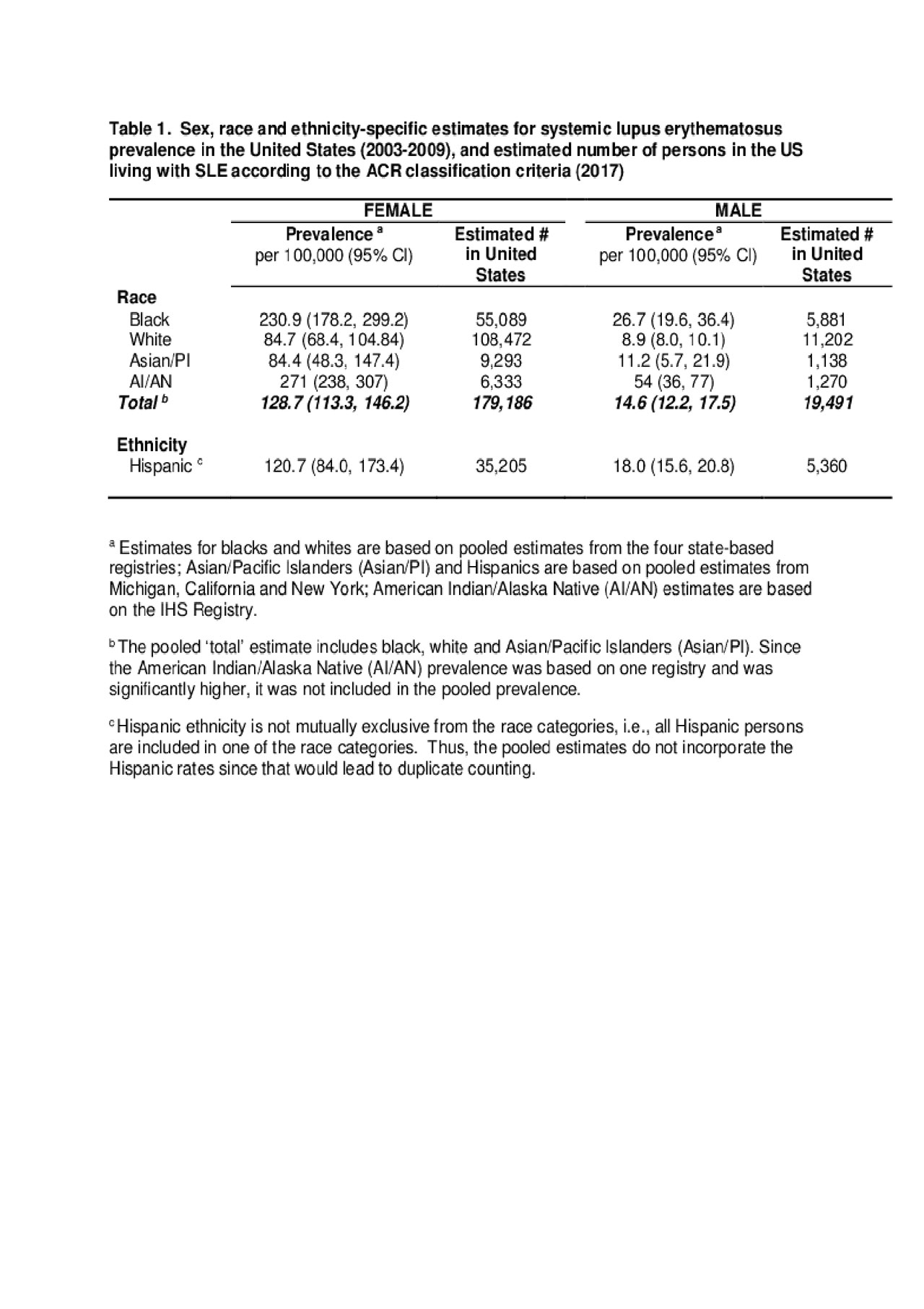Session Information
Date: Wednesday, November 13, 2019
Title: 6W013: SLE – Clinical VI: Epidemiology, Diagnosis, & Outcomes (2882–2887)
Session Type: ACR Abstract Session
Session Time: 9:00AM-10:30AM
Background/Purpose: The heterogeneity of the clinical manifestations of systemic lupus erythematosus (SLE) and lack of a diagnostic test make SLE difficult for epidemiologists to study. The Centers for Disease Control and Prevention (CDC) supported five population-based SLE surveillance registries, using harmonized methodology, to better estimate incidence and prevalence of SLE in diverse areas in the United States (US). Leveraging these data, we performed a meta-analysis to estimate the general prevalence of SLE in the US.
Methods: The CDC registries were established in Michigan, Georgia, California, New York and the through the Indian Health Service (IHS). All registries used the 1997 revised ACR classification criteria for SLE as their primary case definition, and the surveillance time periods ranged from 2003 to 2009. Age-standardized prevalence was stratified by sex and race/ethnicity from the state-based registries; the American Indian/Alaska Native (AI/AN) estimate was based on the IHS registry that covered multiple states. For pooling data across the four sites with data on different racial/ethnic groups, we used Cochran’s Q and I² statistic to test for heterogeneity across sites. Due to significant heterogeneity, we used a random effects model to calculate pooled prevalence, which allows for more variation across sites. We then extrapolated to the 2017 Census population data according to sex and race-stratified groups, including data from the IHS registry, and summed the stratum-specific estimates to provide a total population estimate of SLE cases in the US.
Results: The registries contributed 5,417 classified cases of SLE from a mix of urban and rural areas. From the meta-analysis of the four state-based registries, the overall prevalence was 72.8 (95%CI 65.3, 81.0) per 100,000 population. The prevalence among females was about 9 times higher than males (128.7 vs 14.6). In the meta-analysis, prevalence was highest among black females (230.9, 95%CI 178.2, 299.2), followed by Hispanic females (120.7, 95%CI 84.0, 173.4), white females (84.7, 95%CI 68.4, 104.8) and Asian/Pacific Islander females (84.4, 95%CI 48.3, 147.4). Among males, prevalence followed a similar pattern with the highest rates among black males (26.7, 95%CI 19.6, 36.4) followed by Hispanic males (18.0, 95%CI 15.6, 20.8), Asian/Pacific Islander males (11.2, 95%CI 5.7, 21.9), and white males (8.9, 95%CI 8.0, 10.1). The AI/AN prevalence estimates, which were not included in the meta-analysis, had the highest rates of SLE for both females (271, 95%CI 238, 307) and males (54, 95%CI 36, 77). Applying our sex- and race-specific prevalence estimates to the corresponding population denominators from 2017 Census data, we estimated that 198,677 persons (179,186 females and 19,491 males) in the US fulfill ACR SLE classification criteria, Table 1.
Conclusion: Using estimates from a coordinated network of population-based SLE registries, a more accurate prevalence estimate for the US was obtained. Our methods did not capture undiagnosed, “incomplete”, or other forms of lupus such as cutaneous lupus. Other case definitions may yield different results.
To cite this abstract in AMA style:
Somers E, Wang L, McCune W, Lim S, Drenkard C, Ferucci E, Dall'Era M, Gordon C, Helmick C, Parton H, Izmirly P. Prevalence of Systemic Lupus Erythematosus in the United States: Preliminary Estimates from a Meta-Analysis of the Centers for Disease Control and Prevention Lupus Registries [abstract]. Arthritis Rheumatol. 2019; 71 (suppl 10). https://acrabstracts.org/abstract/prevalence-of-systemic-lupus-erythematosus-in-the-united-states-preliminary-estimates-from-a-meta-analysis-of-the-centers-for-disease-control-and-prevention-lupus-registries/. Accessed .« Back to 2019 ACR/ARP Annual Meeting
ACR Meeting Abstracts - https://acrabstracts.org/abstract/prevalence-of-systemic-lupus-erythematosus-in-the-united-states-preliminary-estimates-from-a-meta-analysis-of-the-centers-for-disease-control-and-prevention-lupus-registries/

